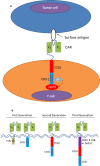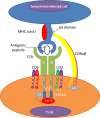Strategies to genetically engineer T cells for cancer immunotherapy
- PMID: 27138532
- PMCID: PMC5424608
- DOI: 10.1007/s00262-016-1842-5
Strategies to genetically engineer T cells for cancer immunotherapy
Abstract
Immunotherapy is one of the most promising and innovative approaches to treat cancer, viral infections, and other immune-modulated diseases. Adoptive immunotherapy using gene-modified T cells is an exciting and rapidly evolving field. Exploiting knowledge of basic T cell biology and immune cell receptor function has fostered innovative approaches to modify immune cell function. Highly translatable clinical technologies have been developed to redirect T cell specificity by introducing designed receptors. The ability to engineer T cells to manifest desired phenotypes and functions is now a thrilling reality. In this review, we focus on outlining different varieties of genetically engineered T cells, their respective advantages and disadvantages as tools for immunotherapy, and their promise and drawbacks in the clinic.
Keywords: Adoptive cell therapy; Chimeric antigen receptor (CAR); Gene-modified T cells; T cell; T cell receptor (TCR); Tumor immunity.
Conflict of interest statement
The authors declare that they have no conflict of interest.
Figures



References
-
- Dudley ME, Wunderlich JR, Robbins PF, Yang JC, Hwu P, Schwartzentruber DJ, Topalian SL, Sherry R, Restifo NP, Hubicki AM, Robinson MR, Raffeld M, Duray P, Seipp CA, Rogers-Freezer L, Morton KE, Mavroukakis SA, White DE, Rosenberg SA. Cancer regression and autoimmunity in patients after clonal repopulation with antitumor lymphocytes. Science. 2002;298(5594):850–854. doi: 10.1126/science.1076514. - DOI - PMC - PubMed
-
- Rosenberg SA, Yannelli JR, Yang JC, Topalian SL, Schwartzentruber DJ, Weber JS, Parkinson DR, Seipp CA, Einhorn JH, White DE. Treatment of patients with metastatic melanoma with autologous tumor-infiltrating lymphocytes and interleukin 2. J Natl Cancer Inst. 1994;86(15):1159–1166. doi: 10.1093/jnci/86.15.1159. - DOI - PubMed
-
- Dudley ME, Wunderlich J, Nishimura MI, Yu D, Yang JC, Topalian SL, Schwartzentruber DJ, Hwu P, Marincola FM, Sherry R, Leitman SF, Rosenberg SA. Adoptive transfer of cloned melanoma-reactive T lymphocytes for the treatment of patients with metastatic melanoma. J Immunother. 2001;24(4):363–373. doi: 10.1097/00002371-200107000-00012. - DOI - PubMed
Publication types
MeSH terms
Substances
Grants and funding
LinkOut - more resources
Full Text Sources
Other Literature Sources

